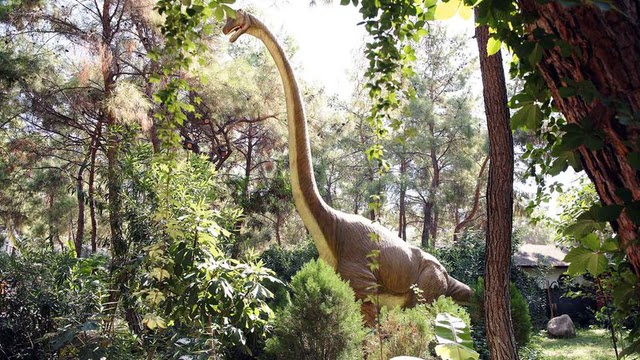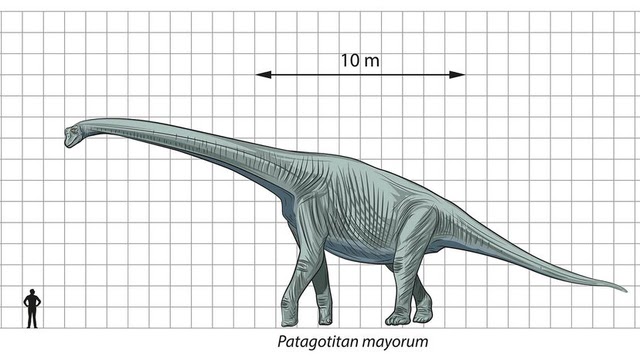Quck answer
Prehistoric animals were often much larger than their modern-day descendants due to factors such as a different climate and available food sources. During the Mesozoic Era, for example, temperatures were higher and there were fewer polar ice caps, providing more habitats for large reptiles like dinosaurs. Additionally, the abundance of vegetation allowed for herbivorous animals to grow to immense sizes. As the climate changed and food sources became scarcer, smaller animals had an evolutionary advantage, leading to the smaller sizes we see today.
Extinct Animals

The Brachiosaurus, a sauropod that lived in North America during the Late Jurassic period, about 154-150 million years ago, is known for its long neck, which is believed to have contributed to its massive size. Aleks49/Shutterstock
Scientists still debate which dinosaur holds the record for being the largest creature to ever exist on Earth. However, a 98-million-year-old skeleton of a long-necked titanosaur discovered in the NeuquГ©n Province of northwest Patagonia in 2012 could potentially take the title. In a study published in 2021 in the journal Cretaceous Research, the authors suggest that it could be “one of the largest sauropods ever found,” even surpassing the size of a Patagotitan, like the one displayed at the American Museum of Natural History that measures 122 feet (37.1 meters) long.
But why did prehistoric animals, such as mastodons, woolly mammoths (whose name means “huge”), and many dinosaurs grow to such enormous sizes in the first place? The answer remains a mystery. However, there are several hypotheses as to why these mammals became so massive. Here are a few:
More Oxygen
One theory suggests that environmental factors, such as higher oxygen levels in the air, contributed to their growth in North America. In 2019, researchers from Rensselaer Polytechnic Institute and the University of Texas at Austin analyzed tiny amounts of gas trapped inside 215-million-year-old rocks from the Colorado Plateau and the Newark Basin using a new technique. “Our results show that over a period of around 3 million years, which is very rapid in geological terms, the oxygen levels in the atmosphere jumped from around 15 percent to around 19 percent,” said lead researcher Morgan Schaller, a professor at Rensselaer Polytechnic Institute, in a press statement. “For comparison, there is 21 percent oxygen in today’s atmosphere. We really don’t know what might have caused this increase, but we also see a drop in CO2 levels at that time.” During this same period, the first dinosaurs appeared in the North American tropics, followed by the massive sauropods.
Efficient Eating
The existence of sauropods leads to another hypothesis about why these mammals grew to such enormous sizes: efficient food consumption. The idea is that because sauropods had long necks, they could consume food more efficiently than other large herbivores, allowing them to cover much larger feeding areas and access food that was inaccessible to other dinosaurs. Therefore, the massive sauropods could grow larger than other dinosaurs because they consumed food more efficiently.

This diagram shows the size of the giant Titanosaur Patagotitan mayorum compared to a human.
EreborMountain/Shutterstock
Cope’s Rule
Finally, there is Cope’s Rule, a hypothesis proposed by paleontologist Edward Cope, which suggests that animals in evolving lineages tend to become larger over time. A study by the Department of Paleobiology at the National Museum of Natural History (NMNH) in 2012 found that Cope was correct, at least some of the time. Using advanced statistical techniques, the team analyzed dinosaur femur bones to determine animal size. They then used that data to look for directional trends in size over time and detectable upper limits for body size.
The National Museum of Natural History’s Department of Paleobiology curator, Gene Hunt, explained that they explored the consistency of Cope’s Rule trend within dinosaurs. They discovered that while some groups, like the long-necked sauropods, followed the rule and grew larger over time, others like theropods, which include the T.rex, did not. Other evidence suggests that prehistoric animals grew massive due to their bones and lungs, allowing them to fly. Pterosaurs had a flow-through respiratory system that helped them sustain flight. Azhdarchids, one of the largest flying pterosaurs, had light bones and a complex system of air sacs, enabling them to grow huge without collapsing. The Supersaurus also had light bones and efficient lungs, giving it a reproductive advantage. Blue whales, growing up to 90 feet in length and weighing approximately 200 tons, make the Supersaurus seem small.
Lots of Additional Information
Related Articles
- Understanding Extinction
- Exploring the World of Whales
- Uncovering the Mystery of Dinosaurs
Sources
- John Alroy’s “Cope’s Rule and the Dynamics of Body Mass Evolution in North American Fossil Mammals” from Science
- American Museum of Natural History’s “The Titanosaur”
- Riley Black’s “Secret Air Sacs Made This Dinosaur Extra Light” from Scientific American
- Leon P. A. M. Claessens’ “Respiratory Evolution Facilitated the Origin of Pterosaur Flight and Aerial Gigantism”
- EurekaAlert.org’s “Rise of Dinosaurs Linked to Increasing Oxygen Levels” and “Were Dinosaurs Destined to Be Big? Testing Cope’s Rule”
- David W.E. Hone’s “The Evolution of Large Size: How Does Cope’s Rule Work?” from Trends in Ecology & Evolution
- Yuki Kanayama’s “Why Did Sauropod Dinosaurs Grow So Big? – A Possible Answer from the Life History Theory” from Journal of Theoretical Biology
- Matt Kaplan’s “Dinosaurs Grew to Outpace Their Young” from Nature
- Natural History Museum’s “Mass Extinctions”
- Martin P. Sander’s “Biology of the Sauropod Dinosaurs: The Evolution of Gigantism” from Biological Reviews
- Brian Switek’s “Whales vs. Dinosaurs: What’s the Biggest Animal of All Time?” from Slate
- Jennifer Viegas’ “Why Dinosaurs Were So Huge” from Discovery
FAQ
1. What caused prehistoric animals to be so much larger than modern animals?
There are several theories as to why many prehistoric animals were so much larger than their modern counterparts. One theory is that the abundance of food and lack of predators allowed for them to grow larger. Another theory is that the higher oxygen levels during the time of the dinosaurs allowed for larger body sizes. Additionally, some scientists believe that the larger size of prehistoric animals was simply due to the fact that they had more time to evolve and adapt to their environment.
2. What were some examples of the largest prehistoric animals?
Some of the largest prehistoric animals include the sauropods, which were long-necked herbivores that could grow up to 100 feet in length and weigh up to 100 tons. Other large prehistoric animals include the megalodon, a massive shark that could grow up to 60 feet in length, and the woolly mammoth, which could weigh up to 6 tons.
3. Why did many prehistoric animals go extinct?
There were a variety of factors that contributed to the extinction of many prehistoric animals. One major factor was the changing climate, which caused many animals to struggle to adapt to new environmental conditions. Additionally, competition for resources and the arrival of new predators may have contributed to the decline of some species. Finally, some scientists believe that a catastrophic event, such as an asteroid impact, may have played a role in the extinction of many prehistoric animals.
4. Are there any modern animals that are as large as prehistoric animals?
While there are no modern animals that are quite as large as some of the largest prehistoric animals, there are still some impressive examples of large animals. For example, the blue whale is the largest animal on Earth, with some individuals growing up to 100 feet in length and weighing up to 200 tons. Additionally, the African elephant is the largest land animal, with some males weighing up to 14 tons.
5. Could humans and prehistoric animals have coexisted?
It is unlikely that humans and prehistoric animals could have coexisted, as many of these animals went extinct millions of years before humans even evolved. Additionally, some of the largest prehistoric animals, such as the sauropods, would have required an enormous amount of food to sustain themselves, making it difficult for them to coexist with other large animals or humans.
6. Are there any theories as to why some prehistoric animals were so strange looking?
There are a variety of theories as to why some prehistoric animals had such unusual physical characteristics. One theory is that these strange features may have helped the animals to adapt to their environment or attract mates. Additionally, some scientists believe that certain physical characteristics may have evolved simply because they were not harmful to the animal and did not negatively impact its survival.





Leave a Reply